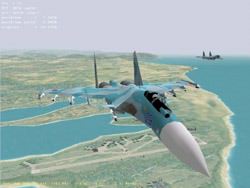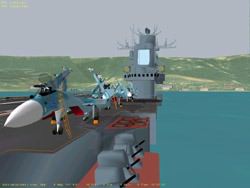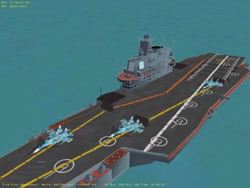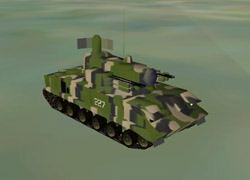|
Flanker 2 PREVIEW By Ed "Brandor" Reddy and Mark "Stinger" Shepheard |
||||
|

Formation over Sevastopol
Ed Reddy's Take on Flanker 2's Features: Flanker 2 almost had the same effect for me when I took off down the runway, except I didn't feel any wind and my eyes were clear as a bell. The aircraft I commanded wobbled a bit from the thrust and as I slowly pulled back on my control stick the Su-33 slowly climbed into the air. I took in the landing gear and climbed to 3000 meters. The terrain looked amazing as it quickly slipped under the belly of my plane. Buildings appeared as I flew over the Crimean city of Sevastopol with amazing ground detail. What a ride! When Su-27 Flanker V1.0 was released a few years back, I thought this simulator was the cat's meow. In the business world, one mantra for success is "location location location". In the flight sim world, the mantra is "detail detail detail." Detailed graphics, detailed flight model, detailed artificial intelligence, detailed modeled SAM and Ships, and detailed weapons. My opinion is that Flanker scored a perfect 10 in all categories, except for graphics, but we can live with a perfect sim without eye candy. As they say "Eye candy is dandy, but being real is the deal". It was not an easy simulator to fly, a number of so-called hardcore pilots gave up on this gem because they could not master the avionics. Well Chuck Yeager once said 'It's the man, not the machine" and the same applies to Su-Flanker. Flanker 1.5 (in its latest form) offers realistic weapons model performance. Expect that S300 to track your bird as accurately as it does in real life. But for those who are disheartened by the difficult flight model from the original version - rejoice. Flanker 2 will have scalable difficulty levels. This means all simulator pilots, at all skill levels, will be able to taste the Flanker experience that for so long was relegated to only the most hardcore fliers. So, what are the changes for Flanker 2 over the current version?
Many more features are planned but have not been finalized, therefore I cannot comment on any of these until I see them for myself in the next release. Now, I will yield the floor so Mark Shepheard can talk about the much improved Flight Model. |

Su-33's, wings folded and wheels chocked on Kuznetsov
Mark Shepheard's Take on Flanker 2's Flight Model: The first astonishing improvement I noticed on my first flight is that when I did a full afterburner take off, the scenery flew by me in a flash. The sense of speed in Flanker 2 is at least twice that of Flanker 1.5...WOW! The entire aircraft feels heavier and much less twitchy than Flanker 1.5 as it displays a slower roll rate more in tune for an aircraft of its size. It feels like there is more inertia and weight modeled as well as drag when the brake, gear, or flaps are deployed. Control surface response at different airspeeds is very well modeled and the aircraft becomes sluggish in slow flight requiring larger stick deflections compared to when the aircraft is at higher speeds. Aileron reversal near critical AoA is also there which is a part of the envelope that is often missed in other sims. There is more speed bleed in high G turns than 1.5 with "Nagging Nadia" letting you know when you have reached, "Maximum G" and "Maximum Angle of Attack". Accelerated stalls are very well modeled when exceeding the critical angle of attack. Stalls are very well modeled and adding flaps will increase lift and decrease the stall speed as that is what happens in the real world. Any type of yaw when stalled will put you into an incipient spin and if you don't react quickly you'll be in a full spin in no time. Spin recovery is also well modeled needing opposite rudder and then a good pitch forward to break the stall once the rotation has stopped and you can really feel it breaking the stall. Inverted flat spins are also possible and are recoverable with the proper control inputs but are much tougher to get out of. Another well done aspect of the flight model is the altitude effects, both a higher True Airspeed as well as less fuel burn at the upper altitudes. Airframe efficiency is also degraded at altitude, as it should be. On approaching to land it is just like the real thing...attitude plus power equals performance and once you have the flaps, brake, hook and gear out and are on glideslope you set your power and make small adjustments to keep it stable. Compared to Flanker 1.5 you will have to hold a higher angle of attack on approach due to the better drag modeling and that runway comes at you fast! I also was able to easily do a forward slip that is used to decrease altitude at a high rate but not increase airspeed. This is done by banking a wing, applying opposite rudder to the bank, and pushing the nose forward which puts the side of the airframe into the airflow and acts as a very large airbrake. The differences in the Su-33 as compared to the Su-27 are many and starting with the physical characteristics are as follows: The Su-33 has forward canards just aft of the cockpit that generate extra lift forward of the center of gravity which is required for carrier take offs and landings. It also has split flaps and outboard ailerons instead of the flaperons on the Su-27. The split flaps extend to about 60 degrees to aid in the approach to the ship by decreasing the angle of attack and are, "split" in order to accommodate the folding wings when stored on the carrier deck. The tailerons also fold up and the gear of the Su-33 is much stronger with dual wheels on the nosegear as well as beefed up front and rear struts. There is also of course the box section tailhook under the tailcone and a nose mounted retractable in-flight refueling probe. The Admiral Kuznetsov aircraft carrier has no steam catapults and the jump ramp on the bow gives the Su-33 enough vertical momentum to allow it the few seconds needed to accelerate to a climbout speed. The flight model seems excellent here in that after the initial jump off the ramp you still have a few seconds of settling towards the water just prior to reaching a climbout speed, It feels very good! The approach to the ship in the Su-33 is somewhat different then the Su-27 since the large split flaps at 60 degrees create a lot of drag so a good amount of power is needed to maintain a stable approach. The ship comes up very fast and disappears under the nose on short final followed by a controlled crash onto the deck catching one of the four wires. As a note, with my head down in the cockpit I was able to complete a full approach to the deck from the outer marker catching the 3 wire all by the panel instruments alone with no HUD or outside reference. Flanker 2's instruments and flight model are THAT accurate...I was very impressed to say the least! The Su-33 also has different in-flight characteristics including different stall speeds and higher maneuverability then the Su-27 from what I found.

Su-33's prepare for take-off In summing up, the Flanker 2 flight model is everything Flanker 1.5 was and much much more, it is very smooth and fluid an will convince even the most demanding sim pilot as well as any real pilot. The bar on flight models has been raised above and beyond anything seen to date and is a credit to the team from Eagle Dynamics.
| F-18's ready for launch | Kuznetsov with aircraft | | Russian Fleet | S300 PMU | Refuelling | F-18 Landing | | Su-33 Landing | Tu-160 |
|
|||
|
This material is copyrighted and may not be reprinted in any form without permission of the publisher. Last Updated January 19, 1999 |
||||

